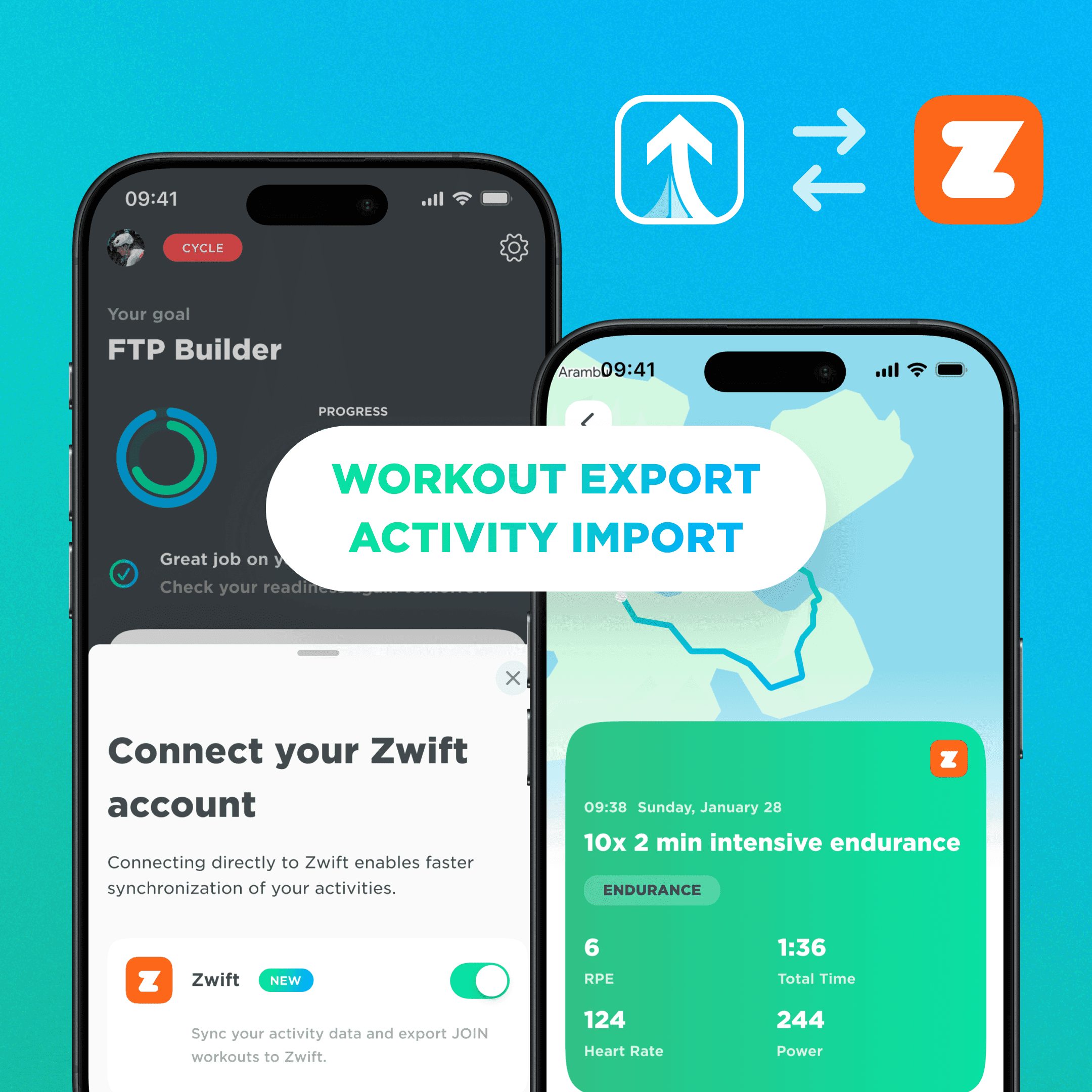What to do with eFTP in the JOIN app?

Dec 16, 2022

What to do with eFTP in the JOIN app?
Dec 16, 2022

What to do with eFTP in the JOIN app?

Dec 16, 2022

In the JOIN Cycling app, you can see the eFTP at your profile in the training statistics overview. This is your estimated FTP. We have noticed that this feature is really appreciated by our users and checked regularly. Therefore, we'd like to tell you a little more about it and how to use it properly within your training plan.
What exactly is eFTP?
The name says it all, it is an estimate, a calculation of your FTP based on your training data. In itself, it is not a new concept. In software like WKO+ (the scientific desktop version of Trainingpeaks) or Trainerroad, this metric also exists. The way it is calculated in JOIN is different (better of course) and may therefore differ from your eFTP on other platforms. Even if the data used as input is exactly the same.
How is the eFTP calculated
The basis of the calculation is your actual FTP. The more accurate and up-to-date you have tested this, the more accurate your eFTP will be calculated. The most accurate method to measure your FTP is an exercise test with lactate measurement in a sports laboratory. However, a 20-minute test is also a great alternative. A 60-minute test or time trial should match your FTP perfectly, but you need to be very experienced to pace this properly. With a 12-minute test - or a so-called 'ramp test' - you're done quickly and the repeatability is greater, but unfortunately determining your FTP becomes quite inaccurate. To properly keep your zones accurate, JOIN schedules a 20-minute FTP test every 3 months.
So the starting point of your eFTP is an FTP that is accurate and current, preferably not older than 3 months. Then, based on the power data you provide, it detects if there are any intervals that warrant increasing your FTP. That's not all, because not every workout is a test or contains all-out efforts. This is why JOIN also models how a ‘regular’ workout affects your FTP. This uses all your available training data in addition to your power data.
An FTP test every 3 months
It is important to stress that eFTP is a calculation. It does not take into account whether you have eaten or slept badly, for example. In practice, your FTP is not the same every day. Yet you don't have to adjust your FTP every day to match the shape of the day. So you don't have to change your FTP based on your eFTP either. In fact, in training, you try to do your intervals within certain ranges based on your FTP. On a good day, this will be in the higher part of the targeted zone than on a bad day.
Therefore, you can confidently do a FTP test and adjust your FTP every 3 months. If after 1.5 or 2 months you already have a much higher eFTP than your entered FTP, e.g. a deviation of more than 15%, you might consider doing a 20-minute test a bit earlier. This might be the case when you have started to train much more from an inactive lifestyle. Then you make a lot of progression in the first few weeks. Under normal training conditions, testing every 3 months is more than enough.
Garbage in is garbage out
If you don't have a power meter or don't know what your FTP is, JOIN will still estimate your FTP and eFTP based on your training data and profile settings. In that case, bear in mind that the accuracy of your eFTP is many times less without a properly measured FTP as a starting point. If JOIN has little training data to analyze, the calculation of your eFTP's development is also much less accurate.
All in all, we are very proud of the eFTP calculation in JOIN. With good input, we found after much testing that our method is very accurate. If the data used in the calculation is of lower quality, the calculated value will be less accurate. So when reading your eFTP, always take into account whether it is based on an FTP that is accurate and up-to-date and how rich the training data you provide is.
In the JOIN Cycling app, you can see the eFTP at your profile in the training statistics overview. This is your estimated FTP. We have noticed that this feature is really appreciated by our users and checked regularly. Therefore, we'd like to tell you a little more about it and how to use it properly within your training plan.
What exactly is eFTP?
The name says it all, it is an estimate, a calculation of your FTP based on your training data. In itself, it is not a new concept. In software like WKO+ (the scientific desktop version of Trainingpeaks) or Trainerroad, this metric also exists. The way it is calculated in JOIN is different (better of course) and may therefore differ from your eFTP on other platforms. Even if the data used as input is exactly the same.
How is the eFTP calculated
The basis of the calculation is your actual FTP. The more accurate and up-to-date you have tested this, the more accurate your eFTP will be calculated. The most accurate method to measure your FTP is an exercise test with lactate measurement in a sports laboratory. However, a 20-minute test is also a great alternative. A 60-minute test or time trial should match your FTP perfectly, but you need to be very experienced to pace this properly. With a 12-minute test - or a so-called 'ramp test' - you're done quickly and the repeatability is greater, but unfortunately determining your FTP becomes quite inaccurate. To properly keep your zones accurate, JOIN schedules a 20-minute FTP test every 3 months.
So the starting point of your eFTP is an FTP that is accurate and current, preferably not older than 3 months. Then, based on the power data you provide, it detects if there are any intervals that warrant increasing your FTP. That's not all, because not every workout is a test or contains all-out efforts. This is why JOIN also models how a ‘regular’ workout affects your FTP. This uses all your available training data in addition to your power data.
An FTP test every 3 months
It is important to stress that eFTP is a calculation. It does not take into account whether you have eaten or slept badly, for example. In practice, your FTP is not the same every day. Yet you don't have to adjust your FTP every day to match the shape of the day. So you don't have to change your FTP based on your eFTP either. In fact, in training, you try to do your intervals within certain ranges based on your FTP. On a good day, this will be in the higher part of the targeted zone than on a bad day.
Therefore, you can confidently do a FTP test and adjust your FTP every 3 months. If after 1.5 or 2 months you already have a much higher eFTP than your entered FTP, e.g. a deviation of more than 15%, you might consider doing a 20-minute test a bit earlier. This might be the case when you have started to train much more from an inactive lifestyle. Then you make a lot of progression in the first few weeks. Under normal training conditions, testing every 3 months is more than enough.
Garbage in is garbage out
If you don't have a power meter or don't know what your FTP is, JOIN will still estimate your FTP and eFTP based on your training data and profile settings. In that case, bear in mind that the accuracy of your eFTP is many times less without a properly measured FTP as a starting point. If JOIN has little training data to analyze, the calculation of your eFTP's development is also much less accurate.
All in all, we are very proud of the eFTP calculation in JOIN. With good input, we found after much testing that our method is very accurate. If the data used in the calculation is of lower quality, the calculated value will be less accurate. So when reading your eFTP, always take into account whether it is based on an FTP that is accurate and up-to-date and how rich the training data you provide is.
In the JOIN Cycling app, you can see the eFTP at your profile in the training statistics overview. This is your estimated FTP. We have noticed that this feature is really appreciated by our users and checked regularly. Therefore, we'd like to tell you a little more about it and how to use it properly within your training plan.
What exactly is eFTP?
The name says it all, it is an estimate, a calculation of your FTP based on your training data. In itself, it is not a new concept. In software like WKO+ (the scientific desktop version of Trainingpeaks) or Trainerroad, this metric also exists. The way it is calculated in JOIN is different (better of course) and may therefore differ from your eFTP on other platforms. Even if the data used as input is exactly the same.
How is the eFTP calculated
The basis of the calculation is your actual FTP. The more accurate and up-to-date you have tested this, the more accurate your eFTP will be calculated. The most accurate method to measure your FTP is an exercise test with lactate measurement in a sports laboratory. However, a 20-minute test is also a great alternative. A 60-minute test or time trial should match your FTP perfectly, but you need to be very experienced to pace this properly. With a 12-minute test - or a so-called 'ramp test' - you're done quickly and the repeatability is greater, but unfortunately determining your FTP becomes quite inaccurate. To properly keep your zones accurate, JOIN schedules a 20-minute FTP test every 3 months.
So the starting point of your eFTP is an FTP that is accurate and current, preferably not older than 3 months. Then, based on the power data you provide, it detects if there are any intervals that warrant increasing your FTP. That's not all, because not every workout is a test or contains all-out efforts. This is why JOIN also models how a ‘regular’ workout affects your FTP. This uses all your available training data in addition to your power data.
An FTP test every 3 months
It is important to stress that eFTP is a calculation. It does not take into account whether you have eaten or slept badly, for example. In practice, your FTP is not the same every day. Yet you don't have to adjust your FTP every day to match the shape of the day. So you don't have to change your FTP based on your eFTP either. In fact, in training, you try to do your intervals within certain ranges based on your FTP. On a good day, this will be in the higher part of the targeted zone than on a bad day.
Therefore, you can confidently do a FTP test and adjust your FTP every 3 months. If after 1.5 or 2 months you already have a much higher eFTP than your entered FTP, e.g. a deviation of more than 15%, you might consider doing a 20-minute test a bit earlier. This might be the case when you have started to train much more from an inactive lifestyle. Then you make a lot of progression in the first few weeks. Under normal training conditions, testing every 3 months is more than enough.
Garbage in is garbage out
If you don't have a power meter or don't know what your FTP is, JOIN will still estimate your FTP and eFTP based on your training data and profile settings. In that case, bear in mind that the accuracy of your eFTP is many times less without a properly measured FTP as a starting point. If JOIN has little training data to analyze, the calculation of your eFTP's development is also much less accurate.
All in all, we are very proud of the eFTP calculation in JOIN. With good input, we found after much testing that our method is very accurate. If the data used in the calculation is of lower quality, the calculated value will be less accurate. So when reading your eFTP, always take into account whether it is based on an FTP that is accurate and up-to-date and how rich the training data you provide is.
More Relevant Articles
Discover valuable training tips to enhance your cycling performance.
More Relevant Articles
Discover valuable training tips to enhance your cycling performance.
More Relevant Articles
Discover valuable training tips to enhance your cycling performance.

Unlock Your Cycling Potential Today
Join thousands of cyclists who have improved their performance with JOIN's training plans.
Probeer het nu
Meer Informatie

Unlock Your Cycling Potential Today
Join thousands of cyclists who have improved their performance with JOIN's training plans.
By joining, you agree to our Terms and Conditions and our Privacy Policy.

Unlock Your Cycling Potential Today
Join thousands of cyclists who have improved their performance with JOIN's training plans.
By joining, you agree to our Terms and Conditions and our Privacy Policy.
Join Now
Join Now



